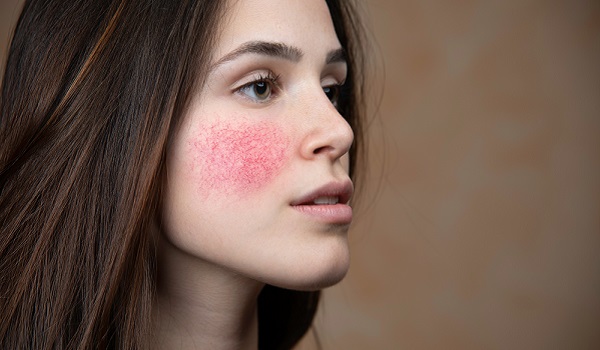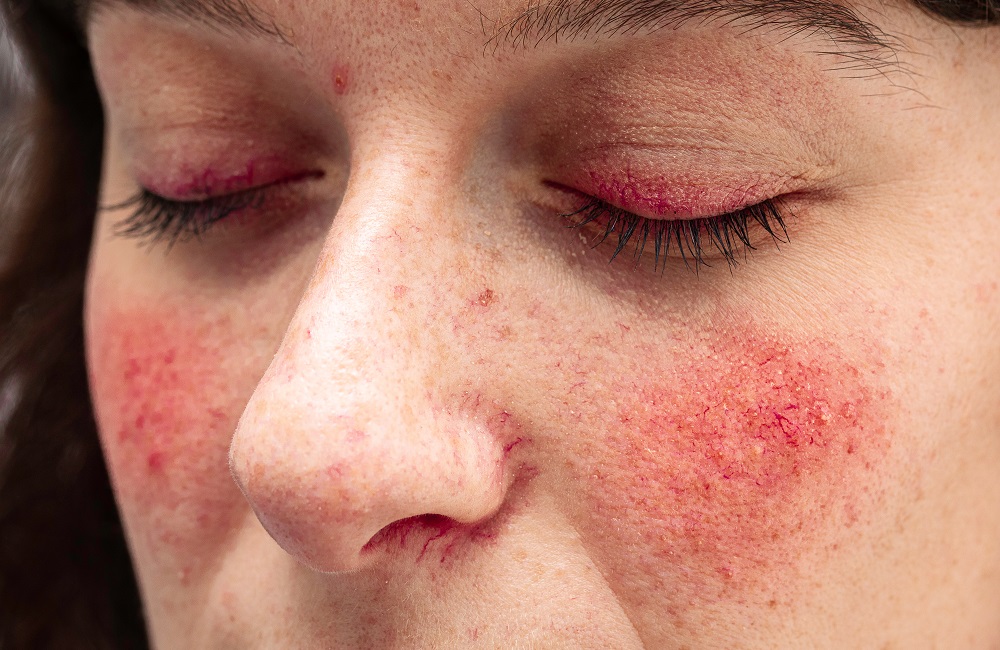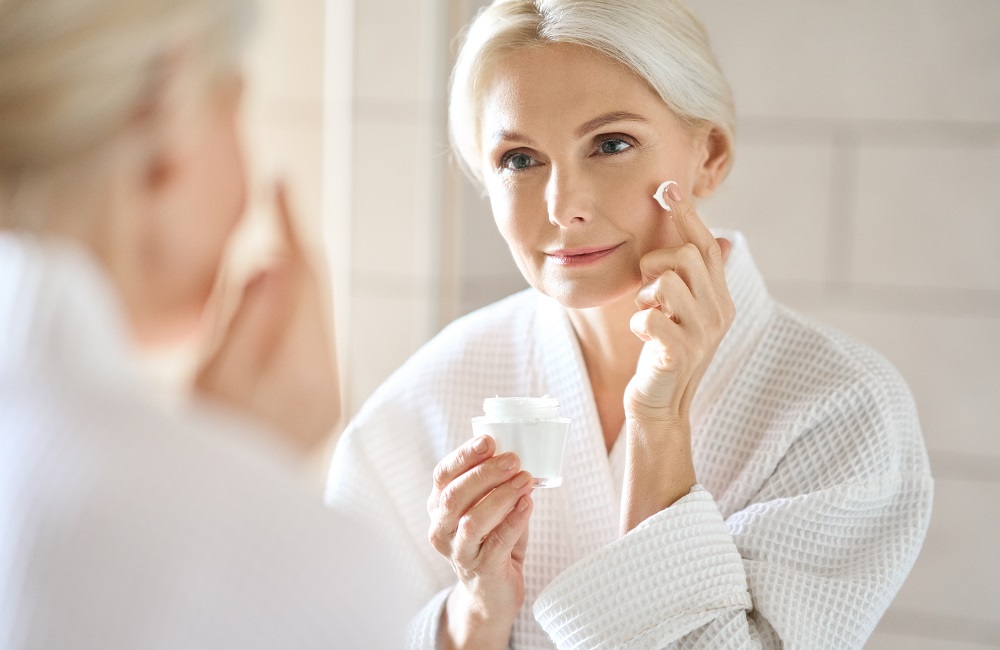What is exactly is
Rosacea?
Rosacea is a non-contagious, chronic skin condition. It is characterized by persistent facial flushing and inflammatory pustules, often in episodes of varying severity. The first signs usually appear between the ages of 20 and 30.
The development of rosacea is influenced by a combination of genetic factors and environmental conditions. Various triggers such as sunlight, heat and stress can exacerbate the symptoms. Although there is no cure for rosacea, there are several ways to control the symptoms and slow down the progression of the condition.
About the symptoms
More information
Important facts about rosacea
Symptoms and consequences of rosacea:
- Persistent facial redness (flushing)
- Visible dilated blood vessels (telangiectasia)
- Sensitive, irritable and dry skin up to burning and stinging
- Inflammatory papules (small raised nodules) and purulent pustules
- Tuberous growths (e.g. bulbous nose)
- Dry, light-sensitive and watery eyes
- Redness of the eyelids and conjunctiva

How does rosacea progress?
However, the occurrence and severity of the individual symptoms can vary from person to person. The disease usually develops slowly and progresses in episodes over a long period of time. There are various forms that can characterize the course of rosacea.
Preliminary stage
In the preliminary stage, rosacea diathesis, there is a temporary and sudden reddening of the skin occurs, especially on the cheeks, nose, chin and forehead.
Stage I, II and III
In stage I, rosacea erythematosa-teleangiectatica, the redness is permanent and the veins are clearly visible. Symptoms such as burning, itching and dry skin may also occur. Stage II, rosacea papulopustulosa, is characterized by the appearance of inflammatory vesicles and nodules. Those affected often feel that their condition is reminiscent of acne. In rare cases, lymphoedema can also develop in the facial tissues. In stage III, glandular-hyperplastic rosacea, nodular skin growths develop mainly on the nose (rhinophyma), but also on the ear, chin, root of the nose or eyelids. Men are particularly affected by this.
Special form
The special form of ophthalmo-rosacea affects the eye and, if left untreated, can lead to severe visual impairment.
In the preliminary stage, rosacea diathesis, there is a temporary and sudden reddening of the skin occurs, especially on the cheeks, nose, chin and forehead.
In stage I, rosacea erythematosa-teleangiectatica, the redness is permanent and the veins are clearly visible. Symptoms such as burning, itching and dry skin may also occur. Stage II, rosacea papulopustulosa, is characterized by the appearance of inflammatory vesicles and nodules. Those affected often feel that their condition is reminiscent of acne. In rare cases, lymphoedema can also develop in the facial tissues. In stage III, glandular-hyperplastic rosacea, nodular skin growths develop mainly on the nose (rhinophyma), but also on the ear, chin, root of the nose or eyelids. Men are particularly affected by this.
The special form of ophthalmo-rosacea affects the eye and, if left untreated, can lead to severe visual impairment.
What causes rosacea?
Although the exact causes of rosacea are not fully understood, some combination of genetic, environmental and immune factors may be involved. However, the occurrence of flares and the worsening of rosacea symptoms can be influenced by a number of factors.
Here are some common triggers:
Sun exposure
Sun exposure
Note: Use sunscreen with a high sun protection factor and avoid excessive sun exposure
Heat and cold
Heat and cold
e.g. saunas, hot water, cold wind, hot drinks
Alcohol and hot spices
Alcohol and hot spices
e.g. red wine, beer and spirits, spicy foods
Inappropriate cosmetics and skin care
Inappropriate cosmetics and skin care
e.g. strong ingredients (alcohol, perfume, exfoliating substances)
Note: Use hypoallergenic products
Stress and emotional strain
Stress and emotional strain
Note: Use relaxation techniques such as meditation, yoga and breathing exercises
How is rosacea diagnosed?
It is advisable to consult a dermatologist at the first signs of rosacea. The doctor will do a skin examination and ask about the medical history, as well as, any factors that make the symptoms worse. This enables him to assess the course of the disease and helps to develop a suitable treatment strategy. In rare cases, a blood sample or facial skin sample is taken to rule out other diseases (such as lupus erythematosus). If the eye is also affected, an examination through an ophthalmologist is also advisable. With proper care and treatment, people with rosacea can improve their quality of life.
Sources
Please note that all content provided regarding individual medical conditions, treatments, procedures, etc. is general information and may vary depending on the doctor and individual case and initial situation.
For more detailed information, please always consult your doctor.
Rosacea" guideline of the German Dermatological Society
www.awmf.orgGether L et al. Incidence and prevalence of rosacea: a systematic review and meta-analysis. Br J Dermatol. 2018 Aug;179(2):282-289.
Schaller M et al. Update from the global ROSacea COnsensus 2019 panel. Br J Dermatol. 2020 May;182(5):1269-1276.
Van Zuuren EJ. Rosacea. N Engl J Med 2017; 377(18): 1754-1764.
